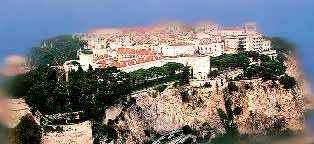 Facts at a Glance
Facts at a Glance
Full country name: Principality of Monaco
Area: 1.95 sq km
Population: 31,800
Capital city: Monaco
People: French 47%, Monegasque 16%, Italian 16%
Language: French, English, Italian, Monegasque
Religion: Roman Catholic
Government: Constitutional Monarchy
Head of State: Prince Rainier III
A tiny speck on France's eastern Mediterranean coast, Monaco weighs in at an awesome 1.95 sq km. There isn't a great deal of geographic variety possible over such a small area. Most of the country is hilly, rugged and rocky, and there are some very fetching sea cliffs.
Those keen on wildlife spotting are best advised to visit the Monaco aquarium. The country is almost entirely urban, and not the best spot for nature lovers. With no forest or woodland cover left here, the only fauna you're likely to see are cockroaches, alley cats and other tourists.
Monaco's climate is typically Mediterranean, with a bit of rain but not too much chill in the winter. Summers are dry and can get very hot. The Monegasque claim they enjoy 300 days of sunshine a year.
Monaco's history is pretty much the history of the Grimaldi family. The country is their private playground, and they are its raison d'etre - a 1918 treaty with France states that, should the Grimaldis die out, Monaco will become an autonomous state of France.
The area which is now Monaco has been inhabited since the Stone Age. Legend has it that during the Roman era a young Corsican Christian named Dévote was executed and her body placed in a boat for Africa. The boat drifted off course and ran aground on the coast of modern-day Monaco, where a state was founded in her honour.
The first serious spate of building in the area - the perimeters of today's Princes Palace - was undertaken by the Ligurians, a Ghibelline Genovese dynasty which ruled Monaco in the 13th century. But on 8 January 1297 the first of the Grimaldis, François, snuck into the citadel behind the backs of the Ghibellines and scored his heirs 700 years' worth of easy living.
In 1489 King Charles VIII of France recognised Monaco's independence. Although they were leading separate lives, and despite Monaco's brief flirtation with Spanish dominance between 1524 and 1641, France and Monaco remained close. Eventually, however, France's possessive nature got the better of it, and in 1793 the new Revolutionary regime annexed Monaco. A treaty signed in 1861 reinstated Monaco's independence, and bickering in recent decades has been restricted to the question of tax laws - Monaco refuses to tax French residents or French companies with their headquarters in Monaco.
Prince Rainier III's fairytale marriage to movie starlet Grace Kelly in 1956 was the icing on the cake of Monaco's glamourous image. When the royal family is made up of leggy models and drop-dead gorgeous screen stars, representative democracy seems a tad dull in comparison. Nevertheless, in 1962 Prince Rainier instituted a National Council elected by native Monegasques, just 16% of the population. As all laws must be passed by the Prince, the Council is mostly for show, and in a country without income tax there's very little to discuss anyway. Besides, with 300 sunny days a year, voting would be a criminal waste of tanning time.
If you scrape off Monaco's flawless make-up, however, you'll find the remnants of a deeply religious, spiritual culture underneath. The legend of Dévote, the country's patron saint and founder, is a cherished part of Monegasque heritage. Every year on 27 January a torchlit ceremony is held for her at the Church of St Dévote. Monaco also venerates saints such as St Roman, a martyred Roman legionary, and St John.
 Money & Costs
Money & Costs
- Budget meal: US$9-11
- Moderate restaurant meal: US$20-25
- Top-end restaurant meal: US$80 plus
- Budget room: US$15-30
- Moderate hotel: US$50-60
- Top-end hotel: US$135-550
Monaco is not a budget destination - over 75% of its hotel rooms are classified as four-star deluxe. There is one hostel and no cheap hotels, although you might get away with paying around US$25 a night for half a double room. However, accommodation in this price range is very scarce, and you'll need to book ahead. If you manage to snap up one of these rooms and you can restrain yourself from splurging at the Casino, you should be able to scrape by on about US$40 a day. Buying your food at the supermarket in the Fontvieille shopping centre is one way to save a few precious francs.
Realistically, most visitors to Monaco will need around $100 a day. This will pay for your mid-range room, a couple of meals and maybe a turn or two on the roulette wheel. On the upside, there's not much more than a day's entertainment in Monaco, so chances are you won't be staying overnight anyway.
Although Monaco's currency is the French franc, there are a few Monegasque coins in circulation, but they're not much use outside the country except as desperate last-minute gifts for your little brother. This is a nation that wants you to spend, spend, spend, and consequently they're falling over themselves to change your hard-earned foreign currency into casino-country cash. Whatever you've got, you shouldn't have too much trouble changing it - there's a plethora of banks around the Casino in particular.


 Facts at a Glance
Facts at a Glance Environment
Environment History
History Economic Profile
Economic Profile Culture
Culture Events
Events Facts for the Traveller
Facts for the Traveller Attractions
Attractions Off the Beaten Track
Off the Beaten Track Activities
Activities Getting There & Away
Getting There & Away Getting Around
Getting Around Recommended Reading
Recommended Reading Lonely Planet
Guides
Lonely Planet
Guides On-line Info
On-line Info